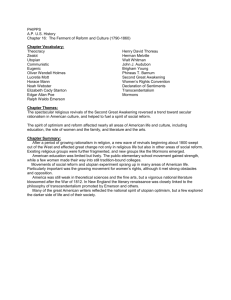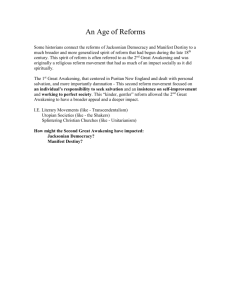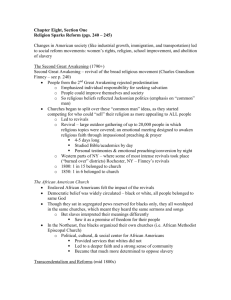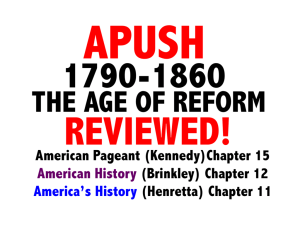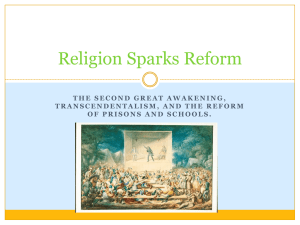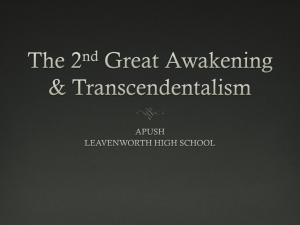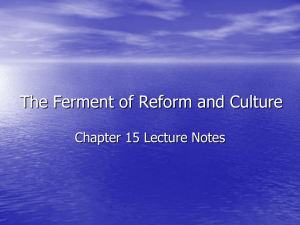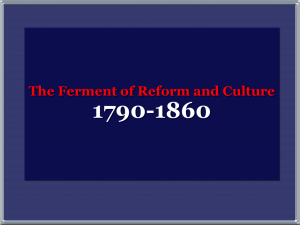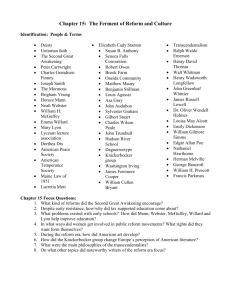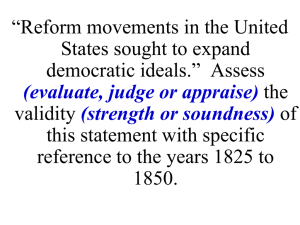Chapter 14 PPT - Spring Grove Area School District
advertisement
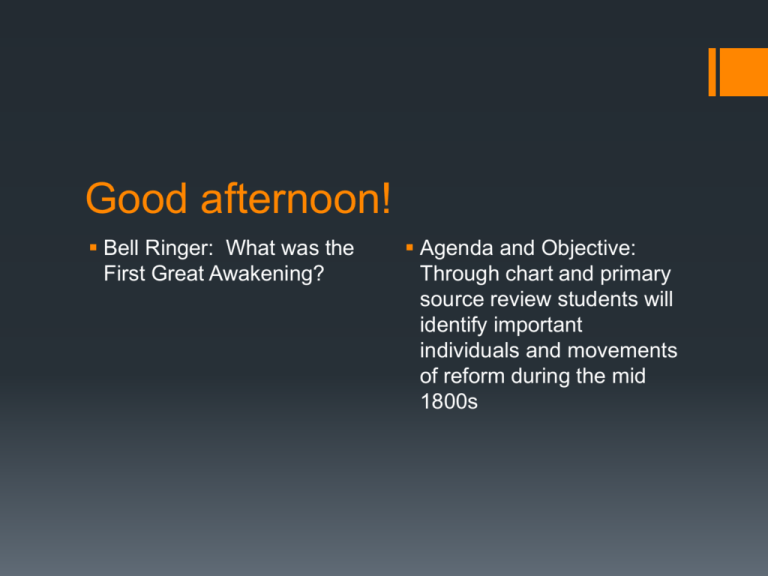
Good afternoon! Bell Ringer: What was the First Great Awakening? Agenda and Objective: Through chart and primary source review students will identify important individuals and movements of reform during the mid 1800s Note Review Chapter 15: Society, Culture, and Reform 1820-1860 Review… The Great Awakening (1730’s-1740’s) First mass social movement in American history Main issues: religious style (personal faith, church practice, public decorum) Reaction against elaborate theological doctrines, emotional stagnation, and liberal doctrines of established churches Great Awakening had a strong democratic component a. People had a number of choices of religion (unlike Europe at the time) b. Represented another example of popular resistance to authority (the established clergy) “The road to Hell is paved with the skulls of unbaptized children!” Who said that??? REVIVING RELIGION Liberalism in religion started in 1800 spawned the 2nd Great Awakening a tidal wave of spiritual fervor that resulted in prison reform, church reform, temperance movement (no alcohol), women’s rights movement, abolition of slavery in 1830s They were partly a reaction against the rationalism belief in human reason Reviving Religion First Great Awakening 1730’s Religious revival in the colonies that was a reaction to liberal doctrine that stressed good works, the evils of Hell, God’s omnipotence and personal involvement Led to a split in churches, more religions, missionary zeal, and demand for more missionaries (and colleges to train them. Notables: Jonathan Edwards, George Whitfield, and Gilbert Tennant Second Great Awakening 1840’s Religious revivals swept through the US during the early decades of the 19th century. They were an attack on rationalism (belief in human reason) and a rejection of Puritan teachings of original sin and predestination. The evangelical spirit of the Second Great Awakening, especially in the Northeast and upper West impacted reform movements during this period Notables: Reverend Thomas Weld, Charles Finney Revivalism and the Social Order Society during the Jacksonian era was undergoing deep and rapid change The revolution in markets brought both economic expansion and periodic depressions. To combat this uncertainty reformers sought stability and order in religion Religion provided a means of social control in a disordered society Churchgoers embraced the values of hard work, punctuality, and sobriety Revivals brought unity and strength and a sense of peace NOTABLES Millenarianism - The preacher William Miller gained tens of thousands followers by predicting a specific date (October 21, 1844) when the second coming of Christ would occur. The Millennialism eventuality turned into the Seventh-Day Adventists Mormons – The Church of Later Day Saints founded by Joseph Smith in 1830. Smith gathered a following in Palmyra NY and eventually migrated to Ohio, Illinois, Missouri and eventually Utah SECTIONAL RELIGIOUS FERVOR NORTH Revivalism in NY Charles G. Finney – 1823 Minister who started a series of revivals in upstate NY. Finney appealed to people’s emotions and fear of damnation and persuaded thousands to publicly declare their revived faith Western NY became known as the “burned-over district” for its frequent fire and brimstone revivals SOUTH Baptists and Methodists These religious sects would travel from location to location to hear dramatic preaching at out door revivals and camp meetings. By 1850 the Methodists had become the largest Protestant denomination in the country. The Spread of Religious Revivals It The was home to many social reformers “ burned-over district” was so heavily The region was home to many nonwho advocated women’s rights & the evangelized that it had Mormons, no fuel (unconverted traditional religions: Millerites, abolition of slavery population) left to burn Spiritualists, Shakers, & the(convert) Oneida utopia A Literary Renaissance Many writers and thinkers of the day adopted the tenets of a movement known as romanticism. advocated feeling over reason and individuals above society. Transcendentalism was an expression of romanticism. The philosophy urged people to transcend the limits of their mind and let their souls embrace the beauty of the universe. Beliefs Religious Groups Unitarians Universalists Mormons Believe Jesus was a great teacher not the Son of God God is a unity, not a trinity Universal salvation Reject the idea of hell Followers of Joseph Smith Believe God is coming and they Need to build a kingdom on Earth to receive him Believe in communal life Shakers Because they did not marry or Have children, their church could Grow only through converts The Transcendentalists Writers like Ralph Waldo Emerson and Henry David Thoreau questioned the doctrines of established churches and capitalistic habits of the merchant class They argues for a mystical and intuitive way of thinking as a means of discovering one’s inner self looking for the essence of God in nature Writers… Ralph Waldo Emerson (1803-1882) “Spiritual matters over material matters” Emerson evoked a nationalistic spirit of Americans by urging them not to imitate European Culture but to create an entirely new and original American culture Henry David Thoreau (1817-1862) Conducted a two-year experiment of living by himself n the woods outside of Concord Mass. He used his observations of nature to discover essential truths about life and the universe. He published Walden in 1854 His essay on Civil Disobedience established him as an early advocate of non-violent protest. He refused to pay a tax that was designed to fund the immoral War with Mexico (1846-1848). He was forced to spend a night in jail The Transcendental ideal? The Brook Farm (1841) George Ripley launched a communal living experiment at Brook Farm in Massachusetts. GOAL – achieve a more natural union between intellectual and manual labor RESULTS -A bad fire and heavy debts ended the experiment in 1849 Others.. Shakers grew to about 6,000 members in various communities by the 1840’s Held property in common and kept men and women strictly separate New Harmony - This secular (non-religious) community was created by Utopian socialists Robert Owen in New Harmony, Indiana Oneida Community (NEW YORK) John Humphrey Noyes started a communal experiment in 1848. Dedicated to an ideal of perfect social and economic equality, members of the community shared property – and even partners Critics attacked the free love and partner sharing aspect of the community, but they still prospered economically by producing high quality silverware REFORMING SOCIETY Reform during the antebellum era went through several stages. At first leaders of reform hoped to improve people’s behavior through moral persuasion. After sermons, pamphlets reformers moved on to political action and ideas to create new institutions to replace the old RFEFORM LEADER CAUSES GOAL United States Temperance Union: Various Excessive consumption of alcohol was widespread among all classes. Abstinence from liquor including prohibition Health Dorothea Dix Inhumane treatment of the insane in prisons: physical punishment & isolation Prison Reform: Rehabilitation & treatment instead of punishment; build asylums for the mentally ill. Women’s Rights Seneca Falls Convention (1848) Elizabeth Cady Stanton, Lucretia Mott Lack of rights concerning property; suffrage; education. Overcome inferior status with a focus on women’s suffrage Education Horace Mann Concern for creating intelligent voters who could support & perpetuate democracy. Free public education (taxsupported); longer school year; teacher training; broad curriculum Abolition Frederick Douglass, Sojourner Truth, William Lloyd Garrison, Harriet Slavery as a moral wrong vs. white supremacy in the South Emancipation (gradual by moderates, immediate by radicals) Women during the early 19th Century…. Republican Motherhood vs. Cult of Domesticity Seneca Falls Rights Movement 1. Govt. gets its authority from the citizens. 2. A selfless, educated citizenry. 3. Elections should be frequent. 4. Govt. should guarantee individual rights & freedoms. The “Virtuous Republic” or moral excellence 5. Govt.’s power should be limited [checks & balances]. 6. The need for a written Constitution. 7. “E Pluribus Unum.” [“Out of many, one”] 8. An important role for women raise good, virtuous citizens. [“Republican Womanhood”]. Roman statesman regarded as a model of simple virtue; he twice was called to assume dictatorship of Rome and each time retired to his farm (519-438 BC) Early 19th Century… Unable to vote Legal status of a minor Could own property IF single Married- no control over her property and children Could not initiate divorce Could not sign wills, contracts, or bring suit to court without her husband’s permission. Republican Motherhood evolved into the “Cult of Domesticity” • • A woman’s “sphere” was in the home (it was a refuge from the cruel world outside). Her role was to “civilize” her husband and family. An 1830s MA minister: • The power of woman is her dependence. A woman who gives up that dependence on man to become a reformer yields the power God has given her for her protection, and her character becomes unnatural! Cult of Domesticity = Slavery The 2nd Great Awakening inspired women to improve society. Angelina Grimké Sarah Grimké Southern Abolitionists R2-9 Lucy Stone American Women’s Suffrage Assoc. edited Woman’s Journal Seneca Falls: First women’s movement in 1849 Educational and professional opportunities Property rights Legal equality Repeal of laws awarding the father custody of the children in divorce Suffrage rights Written by Elizabeth Cady Stanton Welcome Back… Bell Ringer: Share you introductory paragraph from chapter 14 chart with your neighbor as review. Agenda and Objective: Through review activities, students will be prepared for Monday’s quiz. For Monday… Read handouts on Slavery and Southern Economy (Chapter 16) This will substitute your chapter 16 textbook reading. 14/15 quiz on Monday(timed). Review answers will be posted under market revolution and reform on class page. Review…reform movements With your neighbor, match up the reform area with its characteristic.
